| In this first Rijswijk Textile Biennial, the work of sixteen contemporary fine artists who use textiles in their work will be on show. Originally a painter, sculptor or graphic artist, they each realized at a particular point in their careers that textile fibres were the ultimate means of expression for their ideas. In order to achieve this, they had to first familiarize themselves with new techniques and master other materials. They employ time-honoured textile-making skills and materials, often in an unorthodox way and from a modern viewpoint, with the computer frequently playing an important role. |
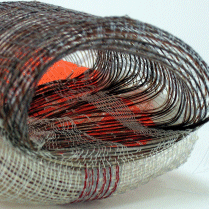
Monika Auch |
Three artists in the exhibition are engaged in weaving. In the constructions created by Monika Auch the impossible appears to become possible: a threedimensional object woven on a flat loom. Auch creates her objects on a computer-driven loom and only when the woven fabric is removed from the loom, are the till then tautly stretched materials free to work together to create three-dimensional shapes. |
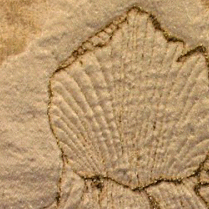
Jan Koen Lomans |
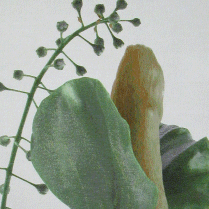
Jeroen Vinken |
Jan Koen Lomans wanted to work in a more tactile way and began experimenting on a computer-driven Jacquard loom in the Textile Museum in Tilburg. He wants to convey the properties of different fibres like mohair, cotton, linen and acrylic in a visible and palpable way. Jeroen Vinken uses the Jacquard technique for completely different reasons; he is fascinated by colour. He writes his own computer programs to create the figures and colours in his fabrics. The human body and organic forms from nature inspire his sensual representations. |
| Woollen blanketing is a material that conjures up associations of softness, warmth and security. Anne van de Pals rudely breaches the apparent safety of old woollen blankets by cutting into them and prying them open. Her sculptures are reminiscent of contorted skeletons and strange organs. Conny Kuilboer emphasizes the softness of the materials in her objects and installations. Challenging images suddenly become cuddly and acceptable, and are given the opportunity to tell their, sometimes poetic, stories. |
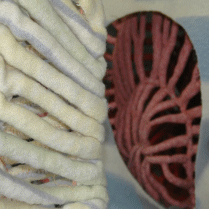
Anne van de Pals |
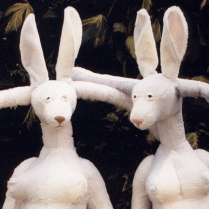
Lidy Jacobs |
Ook Lidy Jacobs also plays with notions such as softness and cuddliness through her choice of materials like plush and mohair. Her sculptures of fairytale creatures " half human, half animal " look sensual and at the same time sensitive and vulnerable. |
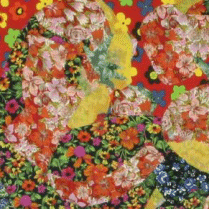
Wilma Kuil |
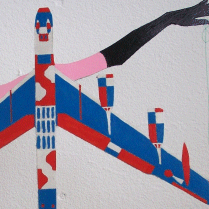
Nancy Pigmans |
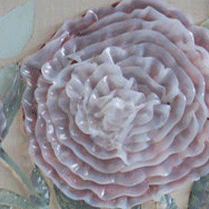
Arjan van Arendonk |
Printed fabrics form the basis of the work by Wilma Kuil and Arjan van Arendonk. Wilma Kuil plays with optical illusions and memories in her work. By applying handmade appliqués or paint, she transforms the design on the fabric, generating a new imagery in the pattern. She also applies the same process digitally: photos are combined with pictures of fabrics on the computer and digitally 'appliquéd' by 'cutting, copying and pasting'. Arjan van Arendonk likes to take his inspiration from massproduced fabrics in his immediate surroundings. He paints over the repetitive motifs of curtain prints with paint and silicone, interrupting the regularity to create new arrangements. |
| Aeroplanes have fascinated Nancy Pigmans since her childhood. She makes them in all sizes ' from small to very big ' in a variety of techniques and materials. Through their orientation in the composition, viewed from below or above, strong metaphors are created: sometimes the aeroplane looks like a cathedral, sometimes a human figure or a crucifix. |
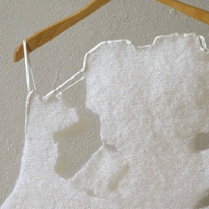
Erna van Sambeek |
| One idea underlies all the work of Erna van Sambeek and she finds textiles the most appropriate way to visualize it. She provokes comment about the most conventional of notions through an eccentric use of textiles. |
For Saskia E.M. van Dijk the fascination is small winged creatures. Her source of inspiration is her father’s insect collection. She knits her insects using darning needles and sewing thread, and mounts them in custom-made display cases to draw our attention to the beauty of these microcosms. |
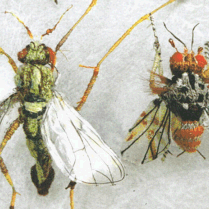
Saskia E.M. van Dijk |
| It is the turn of embroidery with Karola Pezarro and Hinke Schreuders. Piles of old photos formed the source of inspiration that led sculptor Karola Pezarro to work with textiles. She combines various photos on the computer, which she then embroiders by machine and opens up by cutting away parts of the photo to create associative emblems. Hinke Schreuders uses traditional techniques and motifs in her embroidered canvases to focus attention on modern topics. The images of emancipated and sexualized women contrast sharply with the embroidery technique symbolizing the feminine virtues of the nineteenth century. |
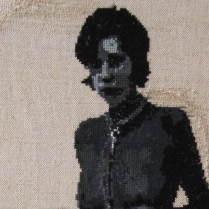
Hinke Schreuders |
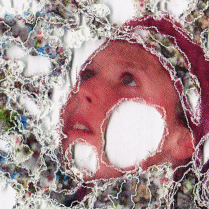
Karola Pezarro |
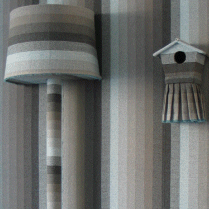
Jet van Oosten |
Marita Kratz also uses the traditional handicrafts of women to comment on the contemporary image of 'the Woman'. Her small crocheted figures are a product of her performance art in which she tries to worm her way into a tight crocheted skin. Jet van Oosten plays with reality and illusion in her work through the subtle use of two- and threedimensionality in combination with textiles. |
| The autobiographical collages by C.A. Wertheim are rather surrealistic and intriguing. She combines the detritus of daily life like used envelopes, lids and caps with manipulated images of herself executed on fabric or paper. |
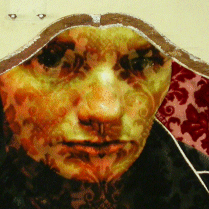
C.A. Wertheim |
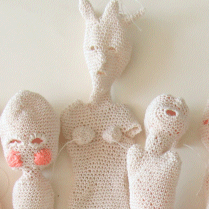
Marita Kratz |